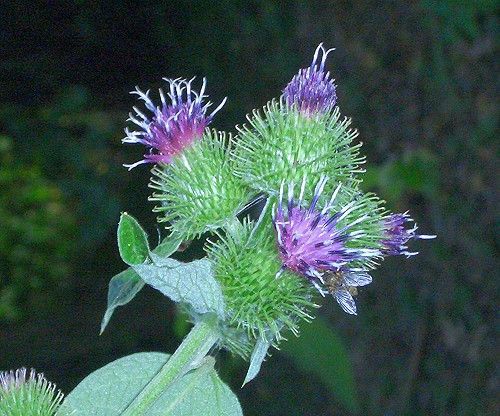 |
 |
(from Living Afield)
Food:
"These large, vitamin- and iron-rich plants were originally brought to North America as food plants. All parts of the plants are edible. Young leaves have been used in salads or boiled as a potherb, though in order to break down the tough fibers the leaves may require 1-2 changes of boiling water and the addition of baking soda. They are said to be excellent in soups and stews. The roots of first-year plants have been peeled, diced or sliced and used in stir-fries and soups or served as a hot vegetable. Mashed roots can also be formed into patties and fried. Some tribes dried burdock roots for winter supplies or roasted and ground them for use as a coffee substitute. The white pith of young leaf and flower stalks has been added to salads or cooked as a vegetable. It was also simmered in syrup to make candy or soaked in vinegar and seasoning to make pickles." (Kershaw 170)
Recipe 1: Gobo
"Gobo is a traditional Japanese recipe made with burdock root.
Harvest and clean 1 large burdock root. The skin should be removed, but it is very thin. Use a potato peeler (use a light touch, no need to dig deep) or a knife to scrape off the skin. Slice into matchstick-size pieces (about 2 cups worth). Place in a bowl of water, and agitate so that the water becomes cloudy. Change water, and repeat several times until becomes clear. Add a drop of vinegar and soak while preparing the rest of the dish.
Slice a small carrot into matchstick-size pieces; set aside.
Heat 1 tablespoon sesame oil in a skillet to medium high. While the oil is heating drain burdock root and add to oil once it is hot. Stir-fry for 2-4 minutes. Add carrots and toss in. Stir-fry for 3 minutes or so. Add 1 tablespoon mirin rice white vinegar, 2 tablespoons sake, 1 tablespoon sugar or palm sugar, and 1 1/2 tablespoons soy sauce. Stir-fry until liquid cooks off.
Serve hot or cold topped with a sprinkle of sesame seeds."
Recipe 2: Dried Burdock Chips
"Wash and peel burdock root as described above. Slice into 1/4"-thick rounds. Arrange on drying rack of a food dehydrator and dry thoroughly. A food dehydrator will take 30 to 48 hors, so plan ahead.
Remove burdock rounds from dehydrator and place onto a serving platter. Top with a dollop of pesto or apricot jam and goat cheese, you can place the rounds on a cookie sheet and melt cheese in oven set to broil for 3 minutes, or until the cheese is melted.
Serve warm." (Morgan 25)
Medicine:
"Burdocks were widely used in tonics for purifying the blood, and they are still recommended as a safe but powerful liver tonic. For centuries burdock was used in medicinal teas for treating gout, liver and kidney problems, rheumatism, vertigo, high blood pressure, measles and gonorrhea. The leaves provided poultices for healing burns, ulcers and sores, as well as teas and washes for treating hair loss, hives, eczema, psoriasis and skin infections. The seeds were also used in washes and poultices to treat bruises, abscesses, insect bites, snake bites, scarlet fever and smallpox. They are also said to stimulate urination and have been used to treat water retention and high uric acid levels. The roots were boiled to make an antidote for use after eating poisonous food, especially poisonous mushrooms. In Japan, common burdock is popular because of its reputation for increasing endurance and sexual virility. Studies have show that burdock can reduce blood-sugar levels, dissolve bladder stones, and stimulate liver and bile function. It may also inhibit mutations, slow tumour growth and relieve water retention, rheumatism, skin problems associated with liver dysfunction and high blood pressure." (Kershaw 170-1)
"Burdock is a widely used blood purifier and alternative, stronger than sarsparilla but less energetic than echinacea and with little of the intestinal effects of Yellow Dock. Echinacea works best when dealing with an active infection or acute toxicity that results in skin eruptions. Yellow Dock is preferable when there are intestinal and liver malfunctions causing the toxicity; --- Burdock, however, works best when there are chronic and nonacute skin sweat or sebaceous eruptions, ranging from acne to psoriasis. ---." (Moore 45)
Other Uses:
"The hooked bristles of these burlike flowerheads are said to have inspired the invention of Velcro." (Kershaw 171)
Internet Resources